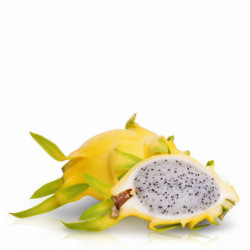- Out-of-Stock


Yellow pitahaya, also known as yellow dragon fruit, is an exotic fruit with an oval or round shape, featuring a bright yellow peel and pointed scales. Its pulp is either white or pale yellow, adorned with small black seeds. Yellow pitahaya has a mild and sweet flavor, often described as a combination of melon and pear. It is juicy and refreshing, suitable for consuming fresh, adding to fruit salads, smoothies, or desserts. It is a source of vitamin C, antioxidants, and dietary fiber.
 Security policy
Security policy
Website built using newest versions, SSL protocols, Secure payments
 Delivery policy
Delivery policy
Receive your order in 24-48h
 Return policy
Return policy
100% Satisfaction guarantee

Guarantee safe & secure checkout
Yellow pitahaya, also known as yellow dragon fruit, is an exotic fruit native to Latin America and is mainly cultivated in Mexico, Colombia, Ecuador, and Peru. Below is a detailed description of this fruit:
Yellow pitahaya is a tropical fruit belonging to the cactus family, known for its scaly skin and sweet, juicy pulp.
With an oval or round shape, yellow pitahaya has a thick, scaly skin in a golden yellow hue. Its interior is filled with small black seeds and yellow pulp with a sweet and slightly acidic taste.
Rich in nutrients, especially vitamin C, essential for skin health, immune system, and iron absorption. It is also a good source of fiber, calcium, potassium, as well as antioxidants and health-beneficial phytochemicals.
There are several varieties of yellow pitahaya, some with thicker and scalier skin and sweeter or more acidic pulps.
Originally from Latin America, yellow pitahaya has been cultivated for centuries by indigenous peoples and has spread to other regions, including Asia and Australia.
From beverages and desserts to salads and main dishes, yellow pitahaya is versatile. Its pulp is used in fruit salads, smoothies, and sauces.
Yellow pitahaya is believed to offer health benefits, such as reducing the risk of chronic diseases and improving digestion.
Known as "dragon fruit" for its scaly skin, yellow pitahaya is also associated with aphrodisiac properties.
Standing out in desserts like yellow pitahaya cream or yellow pitahaya tart, this fruit is a star in Latin American cuisine.
Cultivated in various countries in Latin America, Asia, and Australia, the demand for yellow pitahaya has increased in recent years.